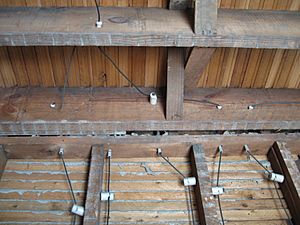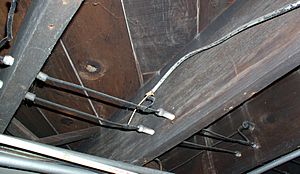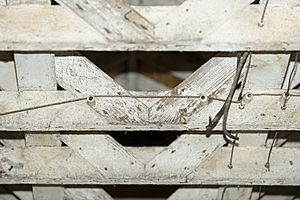Knob and tube wiring facts for kids
Knob and tube wiring (often called K&T) was an old way to wire buildings for electricity. It was very common from the 1880s until the early 1940s. You might still find it in some older homes today, but it's rare.
In this system, wires were held onto wooden beams using special ceramic knobs. When wires passed through wood, they were protected by ceramic tubes. Another non-conducting wire held the electrical wires tightly to the knobs.
A material called loom protected the wires where they entered a junction box. These boxes usually held things like outlets, switches, or light fixtures. Wires were joined together (called splices) by soldering them. Then, they were wrapped in cloth electrical tape. The wires themselves were covered in cotton cloth that was soaked in asphalt for insulation.
To stop short circuits, the "hot" and "neutral" wires were kept far apart. Modern wiring doesn't need this because its insulation is much better. Knob and tube wiring also didn't have a special ground wire. This means it couldn't use the three-prong outlets we see everywhere today. However, special devices called GFCIs can be used to make these old outlets safer and work with three-prong plugs.
Contents
Why Knob and Tube Wiring Can Be Risky
Knob and tube wiring used cloth insulation. Over many years, this cloth can get old, dry, and fall off. This leaves the bare wire exposed. The ceramic knobs and tubes do help protect the wires. Even if the insulation falls off, the bare wire usually won't touch the wooden parts of the house.
However, the insulation itself can catch fire. Some old knob and tube insulation even contained asbestos. Asbestos helped stop fires, but it can cause serious health problems like cancer.
Problems with Splices and Fuses
Unlike modern wiring, the places where wires were joined (splices) were not always inside a protective box. If a splice failed, it could create a spark and start a fire. Also, the old fuse boxes often didn't stop people from using the wrong kind of fuse. Using the wrong fuse could make the wires get too hot, damaging them or starting a fire.
Another issue was that when a fuse blew, some people would replace it with a coin or a ball of foil. They did this if they didn't have a proper replacement fuse. This is very dangerous because it removes all protection against too much electricity.
How Old Wiring Was Different
Modern wiring usually has the "supply" and "return" wires running right next to each other. But with knob and tube wiring, they were often separated. In very old setups, several different circuits could even share the same "neutral" wire. This could cause the wires to get overloaded with too much electricity.
To prevent overloads, these shared neutral wires also had fuses. If a neutral fuse blew or was removed, it could create a dangerous situation. The power might seem to be off, but electricity could still be present.
Risky Switch Connections
Some three-way switches (switches that control a light from two different places) could be wired in a way that was unsafe. The outer metal part of a light bulb socket, which should be safe to touch, could accidentally become connected to the "hot" wire. This could cause an electric shock if someone touched it.
Related Pages
- Aluminum wiring
- National Electrical Code
Images for kids












